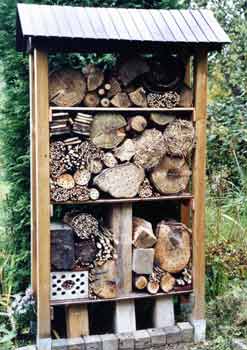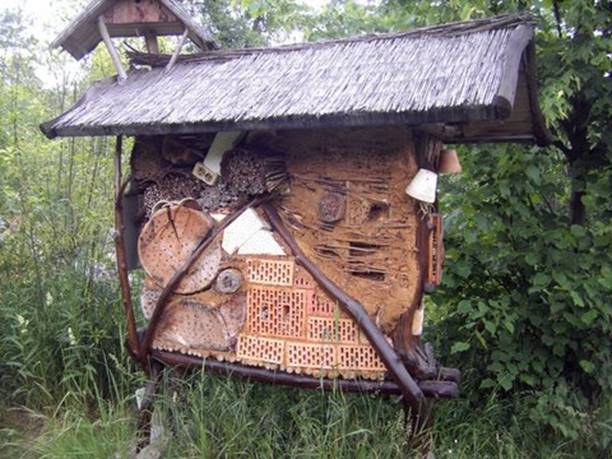nafex@lists.ibiblio.org
Subject: North American Fruit Explorers mailing list at ibiblio
List archive
- From: hans brinkmann <hans-brinkmann@t-online.de>
- To: North American Fruit Explorers <nafex@lists.ibiblio.org>
- Subject: Re: [NAFEX] Fwd: Creating Homes for Wild Bees
- Date: Sat, 05 Apr 2008 15:36:55 +0200
|
Hallo Robert, if I google "insect hotel" I find less photos... but if you google the German "Insekten hotel" you may find many proposals... ciao hans
mullins@gaelicmysts.com schrieb: 3791.165.29.117.142.1207323090.squirrel@www.gaelicmysts.com" type="cite">This is quite cool! Anybody have any 'bee house' designs. I used to work as an entomology aid (but my focus was beetles) at a college. Some of my buddies were into apiaries, but they were just using single cardboard tubes for collection purposes. -Robert C. Mullins M.S. ITBegin forwarded message: From: ARS News Service <NewsService@ars.usda.gov> Date: April 4, 2008 6:48:07 AM PDT Subject: Creating Homes for Wild Bees Reply-To: ARS News Service <NewsService@ars.usda.gov> STORY LEAD: Creating Homes that Please America's Wild Bees ___________________________________________ ARS News Service Agricultural Research Service, USDA Marcia Wood, (301) 504-1662, marcia.wood@ars.usda.gov April 4, 2008 --View this report online, plus photos and related stories, at www.ars.usda.gov/is/pr ___________________________________________ Just like people who are looking for a perfect place to live, some female bees search for the ideal place to build their nests. Agricultural Research Service (ARS) entomologist Theresa L. Pitts-Singer is discovering more about the "nesting cues" that influence wild bees' house-hunting decisions. It's information that may help entice more of the hardworking pollinators to take up residence in new, ready-to-occupy nesting structures that growers and beekeepers provide. Some bees like living in snug, dark recesses called "nesting cavities." These range from deep holes drilled into wooden boards, to bundles of cardboard tubes or hollow reeds. Growers and beekeepers place bee housing in orchards and fields where they need the bees to live and work. Wild bees augment the work of the European honey bee, currently plagued by a puzzling problem known as colony collapse disorder. That's according to Pitts-Singer, with the ARS Pollinating Insect Biology, Management and Systematics Research Unit in Logan, Utah. Scientists already know that female blue orchard bees (Osmia lignaria) and certain other wild bees prefer to nest in cavities that other females of their species once occupied. That's problematical because old nests may be contaminated with disease-causing spores. To find out what's making old nests alluring, Pitts-Singer is investigating components from the old homes, including old pollen, leaves, mud, and a fluid bees apply to cavity walls. In one test, Pitts-Singer and colleagues used glass tubes to approximate drilled nesting holes, then collected the now-dry fluid that bees had left on walls. The scientists are using sophisticated laboratory instruments to glean some of the first-ever information about the chemical composition of the fluid. Perhaps secreted by bees to differentiate one home from another, the fluid may also add to the overall appeal of a previously occupied nesting site. If that's the case, Pitts-Singer's investigations might lead to using synthetic versions of the fluid to make tomorrow's new nesting structures more inviting. ARS is the U.S. Department of Agriculture's chief scientific research agency. ___________________________________________ This is one of the news reports that ARS Information distributes to subscribers on weekdays. Send feedback and questions to the ARS News Service at NewsService@ars.usda.gov. * Other ARS news products are available by e-mail. For details about them or to subscribe, please contact the ARS News Service or visit http://www.ars.usda.gov/is/pr/lists.htm. __________________________________________ ARS News Service, Information Staff, Agricultural Research Service 5601 Sunnyside Ave., Room 1-2251, Beltsville MD 20705-5128 NewsService@ars.usda.gov | www.ars.usda.gov/news Phone (301) 504-1636 | fax (301) 504-1486 _______________________________________________ nafex mailing list nafex@lists.ibiblio.org Reproduction of list messages or archives is not allowed. This includes distribution on other email lists or reproduction on web sites. Permission to reproduce is NEVER granted, so don't claim you have permission! **YOU MUST BE SUBSCRIBED TO POST!** Posts from email addresses that are not subscribed are discarded. No exceptions. ---- To subscribe or unsubscribe, go to the bottom of this page (also can be used to change other email options): http://lists.ibiblio.org/mailman/listinfo/nafex File attachments are NOT stripped by this list. TAKE STEPS TO PROTECT YOURSELF FROM COMPUTER VIRUSES! Please do not send binary files. Use plain text ONLY in emails! NAFEX web site: http://www.nafex.org/_______________________________________________ nafex mailing list nafex@lists.ibiblio.org Reproduction of list messages or archives is not allowed. This includes distribution on other email lists or reproduction on web sites. Permission to reproduce is NEVER granted, so don't claim you have permission! **YOU MUST BE SUBSCRIBED TO POST!** Posts from email addresses that are not subscribed are discarded. No exceptions. ---- To subscribe or unsubscribe, go to the bottom of this page (also can be used to change other email options): http://lists.ibiblio.org/mailman/listinfo/nafex File attachments are NOT stripped by this list. TAKE STEPS TO PROTECT YOURSELF FROM COMPUTER VIRUSES! Please do not send binary files. Use plain text ONLY in emails! NAFEX web site: http://www.nafex.org/ |
-
[NAFEX] Fwd: Creating Homes for Wild Bees,
Lon J. Rombough, 04/04/2008
-
Re: [NAFEX] Fwd: Creating Homes for Wild Bees,
mullins, 04/04/2008
- Re: [NAFEX] Fwd: Creating Homes for Wild Bees, hans brinkmann, 04/05/2008
- Re: [NAFEX] Fwd: Creating Homes for Wild Bees, William C. Garthright, 04/04/2008
- <Possible follow-up(s)>
- Re: [NAFEX] Fwd: Creating Homes for Wild Bees, JAMES ELIE, 04/04/2008
- Re: [NAFEX] Fwd: Creating Homes for Wild Bees, JAMES ELIE, 04/04/2008
-
Re: [NAFEX] Fwd: Creating Homes for Wild Bees,
mullins, 04/04/2008
Archive powered by MHonArc 2.6.24.


